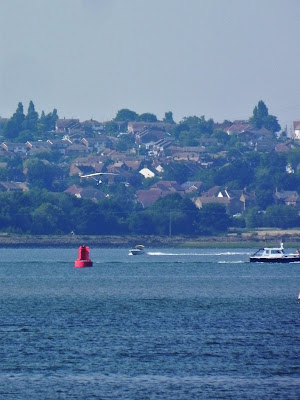If you are prepared to bring your own folding chair, the board can act as a fairly poor windbreak.
28/08/17
06:00-08:00
 |
| Robin- common beach feeders on Horrid |
Point- Single Reed Warbler.
Viz mig- Seven Yellow Wagtail south, five Common Tern south-west. Two Grey Wagtail east-northeast (the usual direction for early autumn dispersal as birds move downriver)
Offshore- Two Kingfisher on the rocks either side of the Point; once they met up, a chase to Copperhouse ensued.
So, quiet then- back to yesterday's game of count the dispersing wader roost. The texts will say waders tend to leave in a set order, this does does generally work as a rule. Each day brings differences; on a slightly lower tide, more Redshank had been able to hang on at the Rainham saltings roost and there was less urgency to return, and the Curlew had roosted on Oakham, so were in no mood to rush back.
In general though, tide-edge followers are first away. With few Dunlin in, it could be blink-and-you-miss-them. Black-tailed Godwit are happy to start feeding close to shore (and can remain until disturbed). Some Grey Plover and Redshank established territories on the flats. A good many others are still working as loose flocks; these mix-in, often wanting to get to their spots as soon as uncovered, so the movement is pretty much over once the main departure takes place. Turnstone aren't really living up to their names at the moment, carrying out an awful lot of 'peck-feeding' on the mud (most are refueling to continue their migrations south, our overwinterers have yet to arrive). The larger the wader, the slower out the blocks. Oystercatcher and Curlew are among the last to leave roost. Presumably their specialist feeding techniques mean they are not having to compete with other species that much, can feed up and retire. Or, they like to supplement the mudflat feeding with a bit of fieldwork when the ground is damp, so they can carry on over throughout a tidal cycle if needs be.
Not setting the world alight with such observations, just enjoying seeing the texts come to life, and getting to understand more about how all the habitats in and around the estuary play a part. The land migrants might be missing, but there's always something to enjoy.
-----
Rewarded myself with a second trip at high tide (having made a covering tide count nearby). Impressed to find a minimum of 880 Starling using Horrid as a high-tide roost. The idea that large roosts act as 'information centres' felt spot on; the constant short bursts from individual birds felt like a 'look at me, I'm well-fed'. Anthropomorphic twaddle, but fun nonetheless.
And something even the public noticed. A couple stopped me (thinking that I looked liked someone who'd know about birds, think the 'scope gave it away) to ask all about them, and then said they'd heard about murmurations thanks to 'Autumnwatch' and would love to see one. Gave them details, but made me think *memo to County Society/ local RSPB Groups*- why not hold a well- promoted/publicised trip to view a murmuration, for the general public? (You're welcome.)
Shame to see the Nor and Friars roosts cleared by a low-flying microlight. Certainly when Kingsnorth Power Station was operational the rule of the estuary was no flying below 150 feet; the reverend, working out on Oakham, was often reporting low-flyers. Today's disturbed birds made west for the Greenborough complex, or north (as in the case of the Curlew pictured) to Oakham. Birds need an awful lot of safe sites. Especially when somewhere like Nor (an RSPB reserve) isn't as safe throughout the tide as some believe.






No comments:
Post a Comment
I've been told not all comments are publishing. There seems to be a problem between Blogger and Chrome, and I'm being told if you have a problem you should try a different search engine.
All a pain in the proverbial. Sorry! I'm a luddite/technophobe (still won't even have a mobile phone) so much else is beyond me..
If still doesn't work, pls send me a DM/post to my twitter a/c @dunnokev to let me know- thanks! Kev 18/12/21